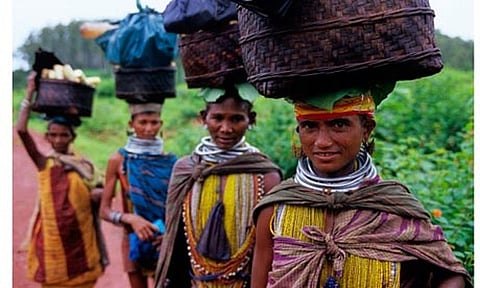It’s still the Dark Ages for Odisha’s Bonda tribe
Bhubaneswar: Despite crores of rupees being claimed to have been spent by the Odisha government over the last few decades for the socio-economic uplift of the endangered Bonda tribe, one of India's most primitive tribal groups, tangible development still eludes them.
Known for their unique culture and traditions, the tribals, divided into two groups -Lower Bonda and Upper Bonda – are till today found semi-nude and perched upon hilly terrain in remote pockets of southern Odisha's Malkangiri district bordering Andhra Pradesh.
Even though the 2011 census has put their population at about 12,000 from 2,565 in the 1941 census, they still reside in 30 villages in the hilly areas spread over 130 sq km of forests and nearly 4,000 ft above the sea level in Khairput Block of Malkangiri. They numbered 9,378 in the 2001 census.
They have their own 'Remo' language – sans a script – which belongs to the Mundari group of languages, while researchers believe them to be members of the Austro-Asiatic language family.
While modern civilization has not changed the Bondas very much, they have comparatively preserved themselves unaffected by the march of civilization and still maintain their primitive social customs and traditions.
With superstitions reigning supreme, unique practices of middle-aged women marrying teenagers, half their age, are still prevalent among the communities, said an official.
However, despite several attempts by the Bonda Development Agency (BDA) – set up by the Odisha government for their development in 1977 – they are yet to be part of the mainstream even as some have accepted the changing systems in society and taking access to education.
"The plans and schemes being implemented by the government should be people-friendly and cater to the exact needs of the local people. The administration should take the tribes into confidence instead of drawing up plans in the (state) capital," Dambaru Sisa, the first legislator from the Bonda tribe, told IANS.
He said the officials at the helm of uplifting the socio-economic condition of the tribe should concentrate on sustainable livelihood and better connectivity in the area.
The state government however claimed that it is taking adequate steps to bring them into mainstream while preserving their very own tradition and culture.
"They would gradually change and be part of society. They have their own tradition and culture and we have to look their comfort. It would take time," SC/ST development secretary Surendra Kumar told IANS.
He said the government has recently decided to spend nearly Rs 800 crore to secure improved livelihood, food and nutrition security for the Particularly Vulnerable Tribal Groups (PVTG).
The programme, to be implemented in the next five years in all 17 micro-project areas located in 12 tribal-dominated districts of the state, would enable improved livelihood, food and nutrition security for 32,091 PVTG households, 13,965 STs, 5,486 SCs and 10,814 other category people living in 542 villages.
The Bonda tribes are getting assistance under Special Central Assistance (SCA) to Tribal Sub Plan (TSP).
They have received Rs 162.58 lakh in 2010-11 under the plan, Rs 146.16 lakh in 2011-12 and Rs 281.65 lakh in 2012-13, said a report of the SC/ST development department.
Similarly, they received Rs 171.04 lakh in 2013-14 and Rs 195.43 lakh in 2014-15. In the current financial year, the tribes received Rs 177.94 lakh, the report added.
According to government sources, 13 PVTGs out of 75 such identified in India live in Odisha. They mostly live in 542 habitations spread across 20 blocks of 12 districts. These tribes are Boihor, Mankidia, Hill Khadia, Juanga, Lodha, Paudibhuyan, Soura, Kutia Kondha, Dongaria Kondha, Lanjia Soura, Bonda, Diyadi and Chuktia Bhunjia.
(Chinmaya Dehuri, IANS)


